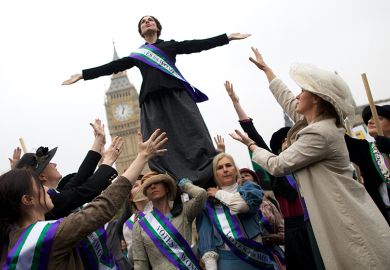Reconciliation of Christianity with homosexuality (male or female) is a lively issue nowadays. One approach, most fully exemplified by John Boswell's Christianity, Social Tolerance and Homosexuality (Chicago, 1980), entails reinterpretation of Biblical passages in an attempt to narrow down what exactly it is that their authors prohibit, emphasis on the early medieval Church's apparently rather relaxed attitude to homosexuality (Boswell dates the rise of uncompromising intolerance to the 12th-13th centuries), special pleading to explain the ferocious laws of, for example, Justinian and the Visigoths, and a ready deployment of "must have" and "may have". Some more recent writers, in semantic desperation, have suggested that the Greek phrase para phusin in Romans 1.26 denotes violation of social custom - despite the long-standing opposition between phusis "nature" and nomos "custom", "law", "convention".
The second approach is to judge that homosexuality was one matter (the fires of hell and the subordination of women are others) on which pre-Christian cultures that condemned homosexuality, St Paul himself, his early commentators, and exponents of Christian doctrine in general until recent years, were simply wrong, and that their "authority" should be rejected in favour of more agreeable views. Bernadette Brooten's book belongs to this second category. It ends with a sentence cast in religious language: "By understanding our past, we may progress towards a more humane future, one in which we acknowledge the sacredness and holiness of a woman expressing her love for another woman."
"Goodness" would have been more appropriate term than "sacredness and holiness", and much more acceptable to readers who can detect contradiction, because the conclusion of the central section of the book, in which the background, interpretation and effects of Romans 1.26f. are discussed, is: "Paul's condemnation of ... female homoeroticism reflects and helps to maintain a gender symmetry based on female subordination. I hope that churches today ... will no longer teach Rom 1:26f. as authoritative."
The inescapable implication of these words is that any pronouncement by any apostle, preacher, theologian or guru at any time and place (including 20th-century America) on what is or is not "holy" and "sacred" may well be the product not of revelation, inspiration or religious insight, but of societal assumptions and predilections.
For agnostic readers (of whom this reviewer is one) there is nothing in the least objectionable in that implication, but to convert "may well be" into "is" in a particular case we need a bit more. Brooten in fact gives us a great deal more: a judicious and richly documented survey of lesbianism in antiquity - that is to say, a survey of what was thought and said about it in Greek, Latin and rabbinic literature, because information on individual cases is scanty. Among those cases, Sappho is the most famous, and Brooten is able to add one or two women in Roman Egypt who wrote erotic spells identical in structure with the abundant heterosexual spells that have survived. She also makes very good use of certain literature of the Roman period: the medical works which take lesbianism to be mental illness and prescribe a dreadful operation on the clitoris to "cure it", and (following the late John Winkler's The Constraints of Desire) Artemidorus's detailed interpretation of sexual events in dreams.
In all this material she discerns a consistent presupposition of "symmetry" (I have always called it "asymmetry") in sexual intercourse, in which an active, dominant subject (male) possesses a passive, subordinate object (female or junior male). Given that presupposition, it is not surprising that men recoil from lesbianism as from an "unnatural" monster. Brooten could have made more than she does of an epigram by Asclepiades (third century bc) which vilifies a Samian female couple as "deserters" from the host of Aphrodite and perpetrators of acts which are "dishonourable" or "discreditable" (Brooten's "not beautiful" is one of the exceedingly few mistranslations in the book). It may be remarked that the poet shows himself in other poems to be an enthusiastic pederast, an activity which he treats as falling within the province of Aphrodite.
Two other considerations may be added in support of Brooten's thesis.
One, which does not seem to have made the impression on historians it ought to have done, is that although the Athenians of the classical period had a word (hetairistria) for "lesbian", and one or two vases show women engaged in mutual titillation, Old Comedy, in which almost every aspect of sex is zestfully exploited in the coarsest language as a source of humour, never alludes to lesbianism. The silence suggests that it was regarded as too threatening to be funny, because it devalued the male. It is interesting that the only other subjects on which comedy is silent are menstruation (taboo?) and the plague of 430bc; there are jokes about female masturbation with a dildo.
Moreover, attention should be paid to a phenomenon which Brooten mentions only in passing (except in connection with a Gnostic heresy), the emergence of an ascetic strand in pre-Christian philosophy. In the mid-fifth century bc Herodotus had classed pederasty among eupatheiai, "luxuries", "enjoyments", "the good things of life", and two generations later a character in a dialogue of Xenophon speaks of genital friction as "that which we desire from the beautiful" (the context there happens to be male-homosexual, but the words used for "the beautiful" do not exhibit gender). Plato did not doubt that beauty in a person of either sex can arouse lust in both, but he regarded intercourse which could not be procreative, and therefore did not contribute to the survival of the community, not as disorientation but as "failure to control desire for pleasure". This was in keeping with his theory of the soul, in which to "feed" the appetitive part was to "starve" the rational. Musonius Rufus, a pagan philosopher contemporary with Paul and in certain respects a champion of women, plainly denigrated as an unseemly surrender to pleasure all sexual intercourse which lies outside marriage and has no procreative intention. The negative attitude of early Christianity towards sexual activity was deep-rooted. Brooten's indexes are exemplary and her bibliographical guidance immensely useful, though there is some repetitiousness in the footnotes.
Kenneth Dover is chancellor, University of St Andrews.
Love Between Women: Early Christian Responses to Female Homoeroticism
Author - Bernadette J. Brooten
ISBN - 0 226 07591 5
Publisher - Chicago University Press
Price - £.00
Pages - 412
Register to continue
Why register?
- Registration is free and only takes a moment
- Once registered, you can read 3 articles a month
- Sign up for our newsletter
Subscribe
Or subscribe for unlimited access to:
- Unlimited access to news, views, insights & reviews
- Digital editions
- Digital access to THE’s university and college rankings analysis
Already registered or a current subscriber?



